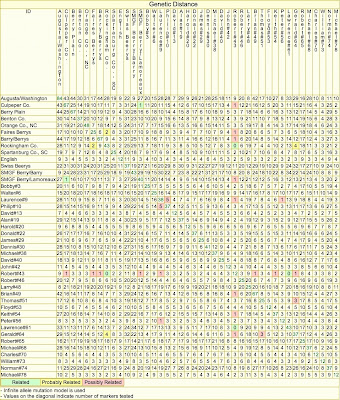Wednesday, January 31, 2007
Culpeper Co. Berrys
I told you last Saturday that I'd talk a little more about the Culpeper Co. Berrys, so here it is.
Here are their allele values -

Their genetic distance table -

And their Time to Most Recent Common Ancestor table -

And finally, their cladogram -

As a matter of interest, and perhaps also instructive, I thought I'd include the distance table representing only the markers compared for the cladogram -
 To generate a cladogram the same markers must be compared with one another and all those compared must have all of those markers. In this case, since I wanted to include the SMGF Berry/Lamoreaux person, we only had 30 markers common to all, thus excluding Richard, #16, who has tested only 25 markers.
To generate a cladogram the same markers must be compared with one another and all those compared must have all of those markers. In this case, since I wanted to include the SMGF Berry/Lamoreaux person, we only had 30 markers common to all, thus excluding Richard, #16, who has tested only 25 markers.Comparing this distance table with the one using all markers, above, we can see that Brent, #4, had two additional marker differences between 30 and 37. If we look at the markers themselves, however, we see that those 'differences' are in CDYa & b, a multi-copy marker, and because of our Non-recLOH Event Multi-copy Marker Distance Counting Protocol we count that as a distance of only 1 as shown by this distance table -
 If any of you Culpeper Co. Berrys recognize this person with a Berry surnamed father and a Lamoreaux surnamed mother and whose pedigree was shown on January 25th, please get him to join the Project! All he has to do is contact me and identify himself.
If any of you Culpeper Co. Berrys recognize this person with a Berry surnamed father and a Lamoreaux surnamed mother and whose pedigree was shown on January 25th, please get him to join the Project! All he has to do is contact me and identify himself.New news! We have a new member and new partial results. Ronald Berry who tested at Relative Genetics joined the Project yesterday. I don't have his yAncestry to post yet but I do know that he matches Laurence, #9, differing by 1 at DYS441 out of 38 markers. They will represent a new 'family' called the New Jersey Berrys.
In addition, Richard,#82, received his Y-DNA1-12 and Y-DNA26-37 markers of his Y-DNA37 order. You will recall that he expected to match Michael, #69, and that they would be the Swiss Beery Family? Not gonna happen. At 24 markers Richard and Michael differ by 23! Michael is haplogroup G and Richard is haplogroup R1b1.
Reminder - If you're thinking about upgrading or ordering any new tests where FTDNA already has your DNA sample on hand, TODAY'S the day to do it to save a week on getting your results. Place the order before 5:00 this afternoon to avoid waiting up to a week additional for the next batch to be shipped out.














































